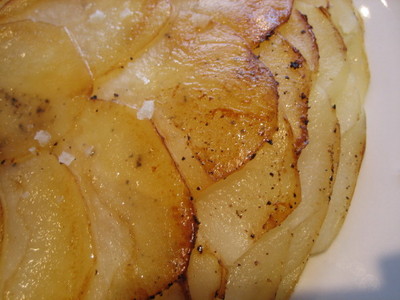Pommes Anna
Well, the exams are all over and I have officially graduated from the
Tante Marie Cooking School professional culinary programme. (Judging by
the quantity of champagne I drank on Friday night and the certificate I
came home clutching, I’m pretty sure that’s what happened, but it’s a
little blurry.) I did pretty well in all the exams, with the exception
of the wine test, which I got 100% wrong. This may come as a surprise
to some, although I can admit to you that I purposefully sacrificed a
few points in exchange for a lifetime’s excuse that I need more practice.
To celebrate the completion of my course, I egotistically decided to
send you the recipe for the very delicious Pommes Anna – crispy on the
outside and tender inside, like me. It’s not my recipe though, rather
the creation of a well known 19th century French chef and named after
the most loved and respected whore in Paris. If it could seduce her,
then it must be worth a try.
 By the way, this dish is really easy to make but you do need a heavy,
By the way, this dish is really easy to make but you do need a heavy,
oven-proof, non-stick frying pan. There are even special copper ‘Pommes
Anna pans’ available at phenomenal expense from posh cookware shops. (I
got a cheap little pan from Ikea that works a treat, but now have my eye
on the real deal, currently going on eBay for just $10… )
Recipe: Pommes Anna.pdf
Serves: 4 as a side dish
Preparation time: 15 mins
Cooking time: 45 mins
50g (2oz) unsalted butter
4 large (or 6 medium) potatoes (neither too waxy nor too starchy; somewhere in between is best)
salt and pepper
- Preheat oven to 180C (350F).
- Melt butter. (To do this dish the truly classic way, clarify it too – ie. skim off the white scum that floats to the surface, and pour off the clarified butter carefully, discarding the watery residue at the bottom.)
- Peel and slice potatoes crosswise very thinly. Use a mandolin or slicing attachment on a food processor if you have one. Do not soak slices in water as they will lose their starchiness, which is essential for binding them together in this dish. Work quickly so they do not oxidise and discolour.
- Liberally coat an approx 8″ heavy, ovenproof, non-stick frying pan with some of the melted butter. Lay in overlapping potato slices in concentric circles, starting in the centre and working outwards, to cover the base of the pan. Brush/drizzle with more melted butter and sprinkle with salt and pepper. Make another layer of potato slices, brush/drizzle with butter and season again. Repeat layers like this until the pan is full. Brush a piece of foil or parchment paper with butter, lay this on top of the potatoes (buttered side down) and press down firmly all over with your hands to compact the slices and flatten. Weight down with a small, heavy pan or lid.
- Cook over a medium heat on the stovetop until you hear a good sizzle and the base starts to brown. You can check by carefully lifting up the potatoes with a spatula. Approx 5-10 mins.
- Transfer to oven and bake until potatoes feel tender when tested with a knife. Approx 40 mins. Remove weight and foil/parchment after 15 mins.
- Turn the dish out like a cake onto a platter and serve in wedges. (To do this I give the pan a shake, clamp a very large, flat, greased saucepan lid over the top of it, then holding the handle of the lid in one hand and the handle of the frying pan in the other, I quickly flip the whole thing over, then carefully remove the frying pan, and slide the potato cake onto the serving platter.) Some Maldon sea salt sprinkled on top is always good.
I’ve cooked this classic French dish many times at school and at home and have always been pleased with the results. It’s golden brown and crispy on the outside, soft and tender on the inside and goes really well with roast meat or pan-fried steak or duck breast. If you love both roast and mashed potatoes, but are bored of making them all the time, try pommes Anna. You can cook it ahead of time, then reheat and turn out when needed.
Pommes Anna notes
To write up this recipe I did some research on its origins. Sadly my namesake did not turn out to be a great poet, painter or princess, but rather a 19th century prostitute. The chef Adolphe Dugléré created this dish in honour of Anna Deslions, who was a favoured regular at the restaurant where he worked in Paris, Café des Anglais. Anna was rumoured to have provided services to 3 kings, l2 emperors, l8 princes, 34 dukes, 2 princesses and several actresses in the upstairs private dining room. So she may have had a dubious profession, but she did it in style. She was the most loved and respected whore in Paris.
Variations
Escoffier and co would scoff loudly at the idea of making any changes to this classic dish. However, playing around with one or more of these variations works well and makes a nice change once you’re bored of plain Anna.
- Make alternating layers of potato and another root vegetable, such as turnip or celeriac. Half the vegetables should remain potato as you need their starch to bind the layers together.
- Sprinkle a little minced garlic and/or grated nutmeg and/or toasted and ground fennel seeds between layers.
Learn more about potatoes…

 Follow
Follow
Comments are closed